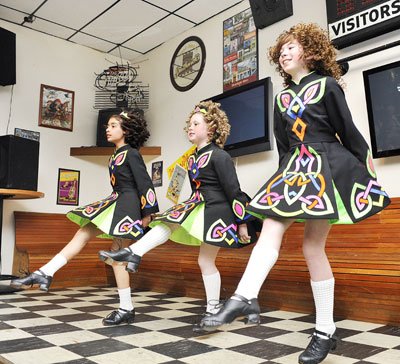
As a certain anonymous adage goes, “there are only two kinds of people in the world: The Irish, and those who wish they were.”
Wherever the origins of that axiom hail, it panders to the reverence Americans hold for a certain holiday in March – the one that involves copious consumption of corned beef and cabbage, inordinate imbibing of Guinness beer and throngs of merrymakers stumbling about in green T-shirts that read, “Kiss me, I’m Irish!”
The comical irony of it all?
“They think it’s a little bit extreme,” chuckled Mike Benson, referring to his fellow countryfolk’s take on the St. Patrick’s Day hoopla in America.
The co-owner of The Claddagh Irish Restaurant and Pub on First Street admits Americans have a tendency to “over-celebrate” the occasion just a wee bit – “but we love it” added Mike. “It’s great to see that going on – that other countries are celebrating our holiday and to see Irish people appreciated so much abroad.”
That’s why we enjoy having Mike around: Not every city has an authentic Irish pub that’s owned by an authentic Irish man (and his fantastic English wife).
With Ireland’s famed holiday just around the corner, the Dispatch dropped a line to the Garlic Capital’s friendly neighborhood Celt. What is it about the Irish culture that Americans resonate with?
“I think there’s a warming to us because the Irish are always being portrayed in history as the underdog,” mused Mike. “We’ve always been oppressed, if you will.”
A reputation for neutrality never hurt, either. Mike says Ireland is a little bit like Switzerland.
“We’ve never done anything to piss anybody off,” he laughed. “That’s a nice thing to be associated with. We’re not on anybody’s bad side.”
And then there’s the accent. Who can argue that Irish people just sound cool?
“Within the first few seconds,” Mike said, contemplating the average amount of time it takes people to ask him, “Are you Irish?”
Fourteen years have flown by since Mike and his English-born wife of 20 years, Lesley, moved to Gilroy in 1997 from San Jose and two years later transformed the space at 1300 First St. near Westood Drive into a “little piece of Ireland.” It’s an apropos characterization of The Claddagh – a kickback, “mom-and-pop” eatery where vintage Guinness advertisements and other old-timey paraphernalia from the Land of Saints and Scholars enlivens much of the wall space.
The pub’s décor wails “Ireland,” naturally – although a hint of Lesley’s personality wards would-be loiterers away from The Claddagh’s outside benches.
“Are you holding a box of pizza or a bag of Crazy Bread?” a sign on The Claddagh’s door asks. It’s directed to patrons of Little Caesar’s, which is located next door.
“If the answer to your question is ‘yes,’ then you should not sit on this patio,” the sign states. “If you do, an angry English lady will come and kick you off.”
As show runner of the restaurant’s day-to-day operations, Lesley wears assorted hats that fluctuate between manager, hostess, buser, waitress, dishwasher, janitor and bartender. She’s also the mastermind behind the menu, dreaming up signature dishes such as Shepherd’s Pie, sausage and mash, the Celtic Calzone, Irish Stew, the wildly popular clam chowder and tasty comfort food like The Claddagh Burger that’s made with Irish bacon (thick-cut bacon from the back of the pig instead of the belly).
Come March 17 – a day Lesley refers to as “organized chaos” where sales will ring up two weeks’ worth of business in one day – she and an army of 35 extra staff members will serve hundreds of pounds of corned beef to hundreds of hungry guests. Mike said his pub burns through seven kegs of Guinness, followed by six to eight kegs of Harp and Smithwicks on an average St. Patrick’s Day.
The Claddagh is, after all, the only Irish watering hole in all of South County.
“It’s just a day where everyone wants to party,” said Lesley, taking a brief break from the morning’s prep work to chat.
In a restaurant festooned with Guinness propaganda, her Widmer Hefeweizen T-shirt made a subtle statement.
Americans in particular, Lesley notes, relate to the Irish culture since many “can say they have a little Irish (in their blood) somewhere, and they’re very proud of that,” she said.
Even the most dedicated of St. Patty’s revelers, however, might be oblivious to the fact that St. Patrick’s Day in Ireland is a family-oriented, religious holiday where people “wear their Sunday best” and attend church.
The patron saint of Ireland isn’t Irish, either (full disclosure: several at the Dispatch had no idea).
Mike says it’s a common misconception to assume that Ireland’s most venerated religious icon is, well, Irish. Known at birth as Maewyn Succat – the revered holy man famous for escaping slavery and later ministering Christianity to Fifth Century Ireland – is actually English.
We also learned that corned beef is not the most popular dish on the Emerald Isle (boiled bacon and cabbage is), and that four-leaf clovers are somewhat of a botanical anomaly often confused with Ireland’s official emblem and government-registered trademark, a three-leafed clover called the Shamrock.
“It’s related to luck for some reason,” said Michael. “I never actually heard of a four-leaf clover until I came to the U.S.”
Not every day is a boisterous pub scene from the 1950s film (John Wayne returns to Ireland) in “The Quiet Man,” either.
While Mike acknowledges Hollywood clichés painting the Irish as bar-propper, binge drinking-fist-fighters, he said pubs in Ireland historically served as a meeting place; a town hall of sorts where the daily news was swapped and spread over a casual pint. Even when Mike, now 51, was growing up, most homes didn’t have a telephone, he recalls.
“The pubs were always busy,” he explained. “So anytime people go to visit Ireland, they go to pubs and think, ‘Christ, they’re always drinking.’”
His own mother didn’t get a telephone until Mike emigrated to the States in 1984 to work for a Sunnyvale software company. Mike had to install one “so I could get in touch with her,” he laughed.
Prior to leaving the Emerald Isle, Mike was raised in Limerick: The third largest and fifth most populous city in Ireland with an urban population of about 90,700 people.
Known for its rich cultural heritage, natural beauty and rural appeal, Mike says he still pictures Limerick as “the little community I grew up in…houses with chimneys with smoke coming out…kids playing football games in the street…there were never any cars…and the river (Shannon) that passes right through there.”
Mike also had a view of the 800 year-old-old King John’s Castle – a formidable stone fortress built by Vikings in the 13th century – from an upstairs window in his home.
As he describes the crisp images of his emerald stomping grounds now a 24-hour plane ride away, Mike’s sense of hometown nationalism still runs strong. It carries over to Gilroy, a place the Bensons and their two children – Colleen, 20; who attended St. Mary’s School and James, 18; a senior at Christopher High School – are contentedly rooted.
“We believe at this point, (The Claddagh) is a staple in the community,” said Mike. “We have some of our amazing regular customers who like that little piece of Ireland that we offer, just from the atmosphere to the great food. There’s a great level of comfort about the restaurant.”
Lesley sees The Claddagh as a welcoming destination for the old, the young, and everyone in-between.
“We have small children that have literally grown up here,” she said, motioning to the main dining room Wednesday morning. “It’s almost like their second home.”
After the 14 years spent weathering economic ups and downs, not to mention the taxing trials of simply staying afloat in the restaurant business, it’s hard to tell what’s more likable about the Bensons: The pride in Lesley’s voice as she praises her loyal and longtime staff members, Michael’s genial sense of humor or the couples’ sense of sincerity as they laud loyal patrons – who hail from the Garlic Capital, to Morgan Hill, to San Francisco, to Half Moon Bay.
Mike said he and Lesley were welcomed in Gilroy with open arms from the very beginning, and “it hasn’t stopped since then.”
“Europeans just don’t get a sense of how great this country is,” said Mike. “Anything can happen in this country if you put your mind to it. The world is your oyster, really. You get out of it what you put into it.”











